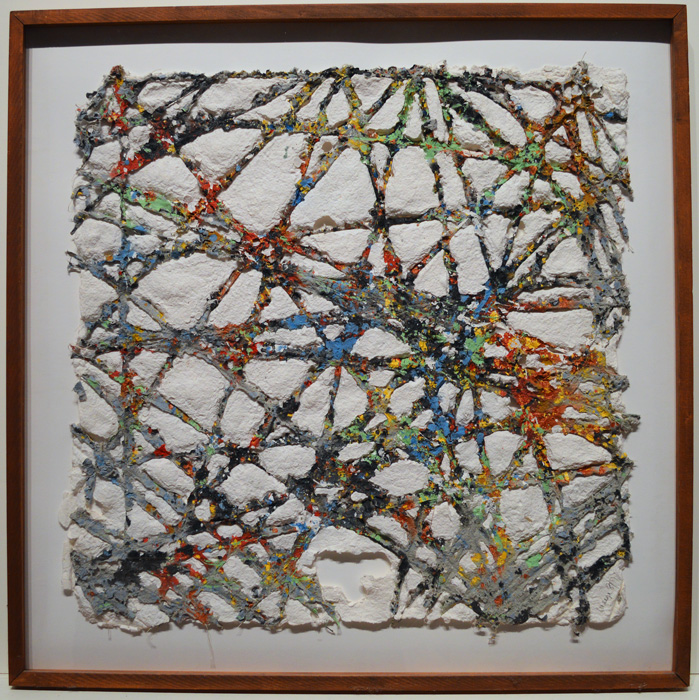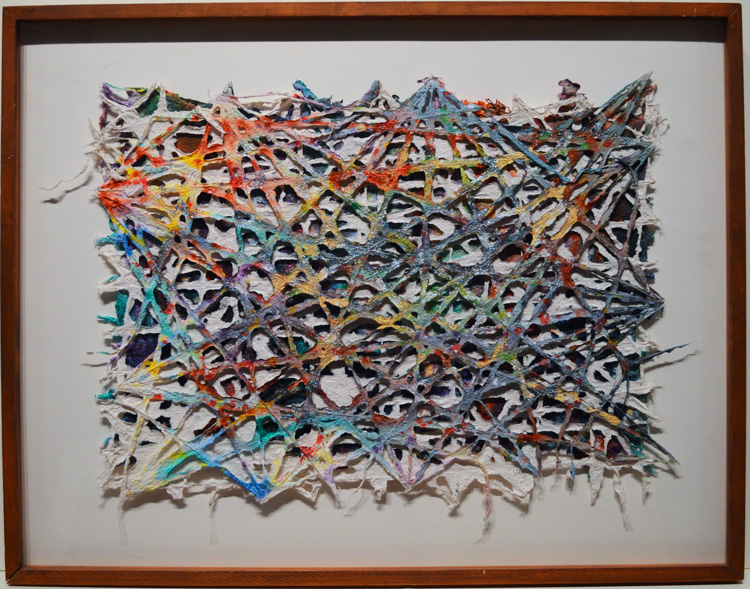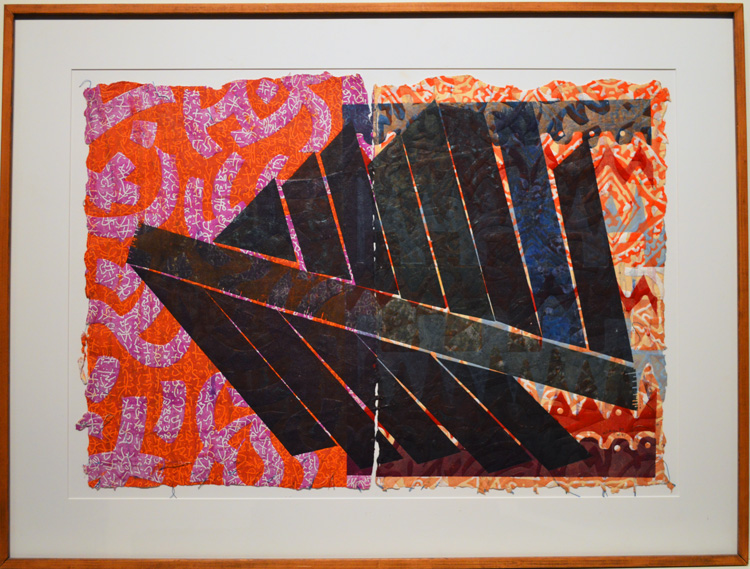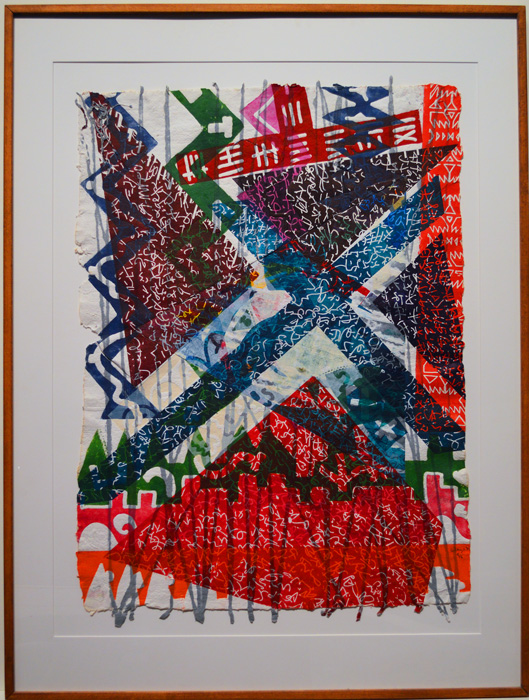|
William Weege (whom everyone calls "Bill") is Professor Emeritus from the UW-Madison Art Department and founder and artistic director emeritus of the University of Wisconson–Madison Tandem Press. Weege worked predominantly with silkscreen because of its immediacy and directness. He created the "print production" area to deal with the emerging photo-based technologies for printmakers. He was particularly interested in adapting graphic arts techniques for fine arts applications. He has also been a leader in the development of digital printmaking. Weege is best known for his large abstract handmade paper projects. His work is most often produced for corporate commissions, as well as for embassies around the world. His work can be seen at the Prudential Building in Minneapolis, the Renaissance Center in Detroit, Honda Headquarters in Tennessee, and in embassies in Finland, Germany, and Chile. His art has shown widely and he has works in the collections of a number of museums including the Brooklyn Museum, the Museum of Modern Art, New York, The Philadelphia Museum of Art, the Detroit Museum of Art and the Sam Francisco Museum of Art, California.
Born in Wisconsin in 1935, he went to the University of Wisconsin, receiving his degree in 1967 and becoming a Project Specialist in the U.W. Art Department. Madison was one of the centers of resistance to the Viet Nam war during the late 1960s and the early 1970s, and Weege’s anti-war posters soon went viral locally and then went national and became de rigeur in college dormitories. In 1970, to coincide with the Venice Biennale, the Smithsonian Institution and the National Collection of Fine Arts organized an "Experimental Printmaking Workshop" in Venice. According to David Acton's introduction to the catalogue raisonné of Weege's Jones Road Print Shop and Stable 1971-1981, "Weege, who had gained some reputation for his experiments with serigraphy, was made Director of the program and took a year's leave from his position as a Project sSpecialist in the Department of Art at the UW to move his family to Venice." In 1970 and 1971 his art was exhibited at the World’s Fair in Japan and the 7th International Biennial Exhibition in 1970, MoMA (the Museum of Modern Art) in 1970 and at the Whitney Museum in 1971. In 1971 he rejoined the UW Art Department as an Assistant Professor of Art, where he taught until he retired in 1999. He established the Jones Road Print Shop and Stable in Barneveld WI and soon artists like Sam Gilliam, Alan Shields, and Jack Beal were trekking out to Madison during the summers when Bill was free of teaching responsibilities (Sam Gilliam was especially fond of working with Bill and between 1971 and 1981, they worked together on 71 editions and monotypes; their collaborations continued after that, but the complete record has not yet been published). After his press was destroyed by a tornado he tried a second time with the Off Jones Road Print Studio, and then convinced the UW to establish the Tandem Press (under his directorship) in Madison in 1987, which became a second home to him, a place where graduate students and visiting artists (including Lynda Benglis, Richard Bosman, John Buck, Suzanne Caporael, Squeak Carnwath, Louisa Chase, Robert Cottingham, George Cramer, Jim Dine, Jane Goldman, Joseph Goldyne, GRONK, Al Held, John Himmelfarb, Karen Kunc, José Lerma, David Lynch, Ed Paschke, Philip Pearlstein, Judy Pfaff, Sam Richardson, Judy Rifka, Jane Rosen, Italo Scango, Miriam Schapiro, Alan Shields, Juane Quick-To-See Smith, Steven Sorman, Art Spiegelman, Robert Stackhouse, Claire Van Vliet, William Wegman, and Ruth Weisberg, among others) came to work on print projects. He has shown his art widely and has works in the collections of the Brooklyn Museum of Art, the Museum of Modern Art, New York, The Philadelphia Museum of Art, the Detroit Museum of Art and the Sam Francisco Museum of Art, California. In 1991 and 1992 he participated in a collaborative project with Sam Gilliam that the Arts America Project Grant exhibited in Finland and Korea. Weege is one of the earlier practitioners in the revival of making handmade paper that started in the 1960s. According to Printmaking in America, "Artists who came to work" with Weege "were encouraged to incorpoprate collage, flocking, sewing, and a wide range of techinques in their works" (Hansen et al, p. 51). Weege is highly regarded for his broad understanding of all aspects of printmaking, but is constantly developing new ways for making art. His enthusiasm and exuberance are infectious and when asked to describe his philosophy for art, he says, “Do it.”
We can get a better idea of how Weege worked by looking at how he worked with other artists who came to work with him via John Beardsley's introduction to Sam Gilliam: Recent Monoprints (Philadelphia: Brandy Wine Workshop, Printed Image Gallery, 1993) who notes that "Weege encouraged him [Gilliam] to freely combine media and techniques, 'to work in the area between painting and prints, sculpture and prints" (p. 8) and goes on to add, "There is almost no way to reconstruct the creation of these prints, so many were the means. They began with handmade paper, sometimes two or three sheets combined. Some of these were taken from the traditional printer's inventory: woodblock, drawn and routed with circular shapes. . . . But others were more unorthodox: objects discovered at a foundry were freely use, including a variety of stencils and even metal shavings. The shapes of still other found objects were embossed directly into the paper. . . . Gilliam then took these prints back to his studio, cut them apart again and stitched them back together—much as he does with his paintings—using heavy nylon filament. Both before and after this collaging, he raked acrylic and gel across the prints; he then printed them yet again. This is Gilliam the printmaker at his most impulsive, even whimsical—the organizing geometry has been reduced to just an arc here, a rectangle there; drawing is loose, and colors are vibrant. In all there is a brightness and freshness . . . that can be directly attributed to their exuberant technique" (pp. 9-19).
Bibliography: John Beardsley, Sam Gilliam: Recent Monoprints (Philadelphia: Brandy Wine Workshop, Printed Image Gallery, 1993), Warrington Colescott, Progressive Printmakers: Wisconsin Artists and the Print Renaissance (Madison: University of Wisconsin Press, 1999)—the chapter on Bill Weege includes full-page color reprodutions of 8 of his works; Trudy V. Hansen, David Mickenberg, Joann Moser, & Barry Walker, Printmaking in America: Collaborative Prints and Presses 1960-1990 (Evanston IL: Northwestern University and Harry N. Abrams, 1995 (this accompanied a travelling show of 4 museums, ending at the Smithsonian); John Loring and David Acton, Jones Road Print Shop and Stable 1971-1981: A Catalgue Raisonné (Madison: Madison Art Center, 1983).
|
|
|



